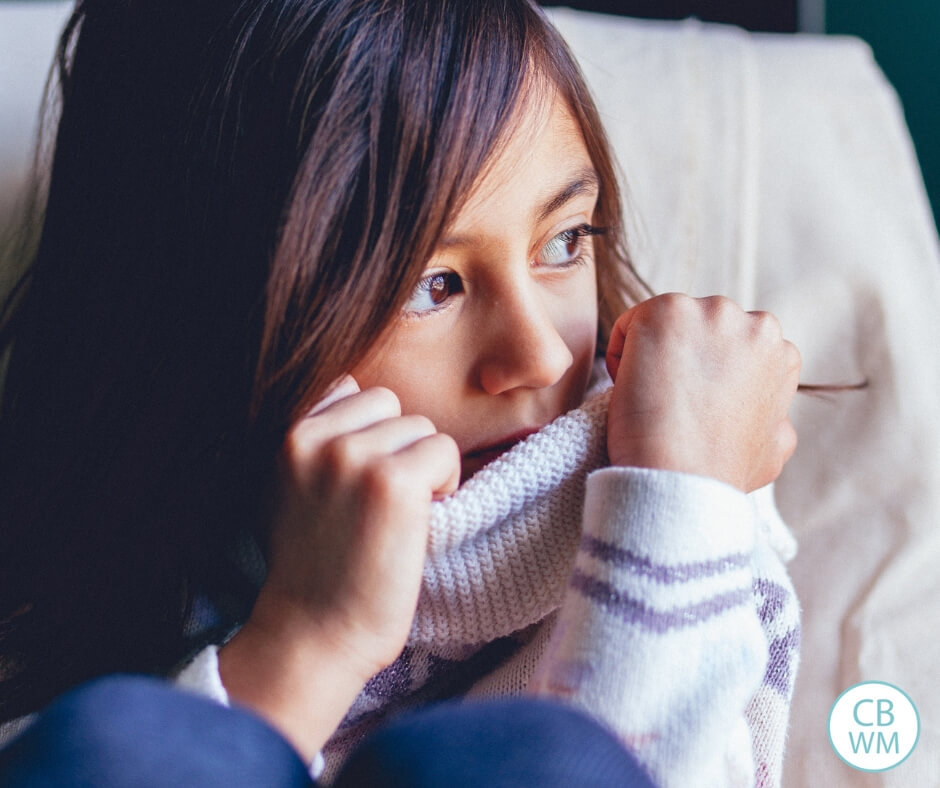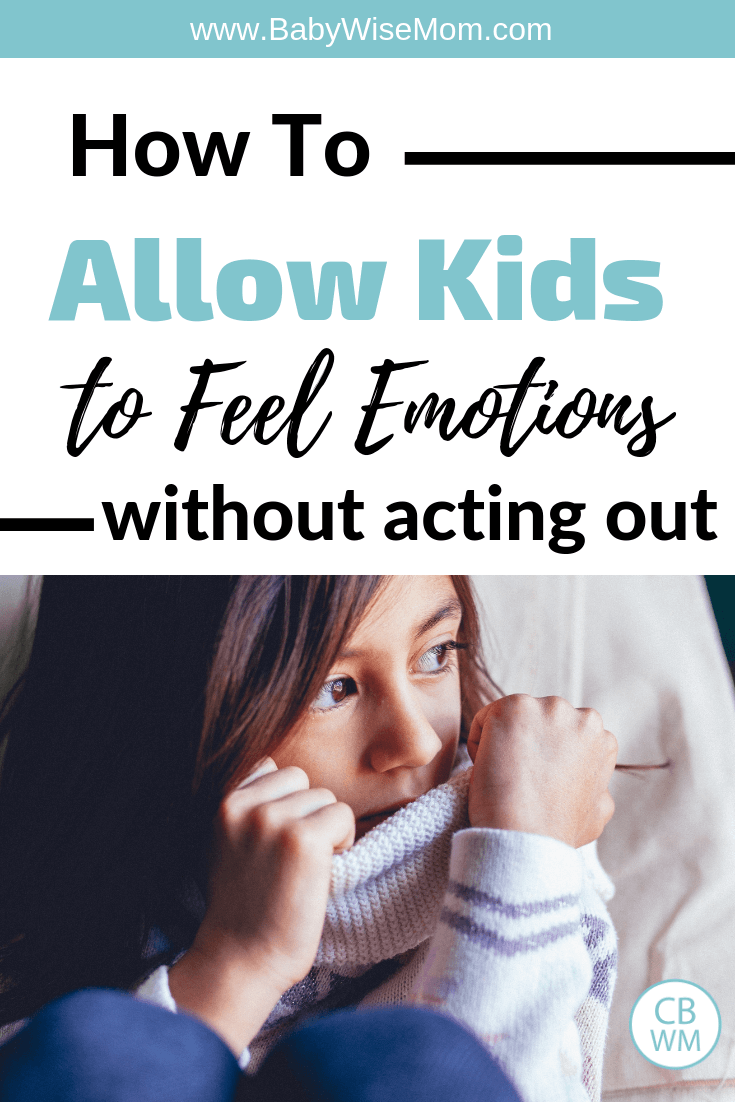How to Allow Children to Feel Without Acting Out. Children can have feelings and emotions, but need to learn to manage them.

Little kids come with big feelings. We all know that. Big feelings, when they are confusing and not understood, lead to tantrums. And no one likes tantrums.
With young toddlers, the goal is to just calm down and overcome the tantrum. Most of the time the tantrums come from a place of frustration. Get past that and you are good to go. (Distraction works great at this age!)
Older toddlers and preschoolers have more complicated reasons for their tantrums. They also have higher expectations for their behaviors. This means tantrums are pretty much not allowed.
While we could just treat tantrums as a discipline issue (do as I say and stop freaking out), that ignores a valuable learning opportunity. Emotions are a part of our lives, and we all need to learn how to deal with them in a healthy fashion.
Here is how we are learning how to feel emotions but not act out on them.
Read: Frustration Tantrums and How To Stop a Tantrum
Post Contents
- How To Handle Big Feelings Without Acting Out
- Calm Down
- Identify the Feeling
- Treat Feelings as Neutral
- Sit with the Feeling
- Talk About How To Get Through the Feeling
- Talk About the Ramifications of Their Actions
- Create a Safe Space for Feelings
- Feelings Cannot Be Controlled, Actions Can
- All About Kim
- Related Posts
How To Handle Big Feelings Without Acting Out
It’s easy to dismiss the feelings of little kids. I mean, what do they really have to worry about in life? But when we treat tantrums as just discipline issues we are doing them a big disservice.
Kids need to be allowed to have feelings. They need to admit what they feel and not learn to bottle it up. I firmly believe kids can feel however they feel.
But they may not act any way they want to act. That means no tantrums, no hitting, no slamming doors, no throwing things, no any other negative behavior. Having a feeling does not take away personal responsibility. My kids are responsible for their actions.
How do you teach your children to do this?
Calm Down
The first step to any tantrum or big feeling is to calm down. Now we all know being told to calm down just makes things worse, so there are a number of other options.
Take deep breaths with your child. Give them a hug. Take your child away from the situation.
Do what you need to do to help your child calm down. This might mean taking a time out (either you or them). Nothing can be discussed or learned in the middle of a freak out.
Do what works for your children. I have one daughter who does well with a big snuggle. My son needs to be alone in her room for a few minutes. Both ways are valid.
Identify the Feeling
Once you are and your child are calm get to talking. What is the feeling? Why are they upset/acting out/tantruming?
It helps to talk through the events leading up to the big feeling. And the more specific you can be about what your child is feeling the better.
This step can actually be hard because there are feelings that we as adults don’t like to admit we have. It’s fine to say you are frustrated or angry, but can you admit when you are jealous? Or being selfish? These are things that kids feel. They need to be talked about.
Work together and name the feeling. Naming gives your child ownership of the feeling and adds to their sense of control.
Treat Feelings as Neutral
Try to talk about the actual feelings in as neutral a light as possible. The goal is not to induce shame along with a feeling. Adding shame makes dealing with emotions harder.
This can be hard because there are feelings with negative connotations. Anger, jealousy, sadness. These are seen as bad things. But I really think feelings on their own are kind of neutral in terms of good or bad.
Is it bad to be sad? No, not if you have a good reason. Is it bad to be jealous? Not if it motivates you to work towards your goals.
Feelings, when first felt, are not controllable. That initial feeling is neither good or bad, it is an honest reaction. I don’t want my kids feeling bad or ignoring their gut feelings.
What comes after that initial feeling is what we are dealing with. So treat that feeling that caused the issue as equal to every other feeling. (And seriously, if as adults we can honestly name our own feelings in a neutral manner it is much easier for us to handle them. The same holds true for kids.)
Sit with the Feeling
Not all feelings feel good. Happiness, awesome. We like to hang out with that feeling.
Can you sit and just feel sad though? It’s a lot harder and a lot less pleasant. But part of handling emotions is learning how to sit and feel the feeling.
This means no yelling, no running, no hitting. Just sit and feel.
There are a lot of times in life when we cannot act the way we want to. That doesn’t mean we just turn off our feelings. You can have a feeling and do nothing.
What’s the point of this? To recognize, to really hone in on what this emotion feels like. We can’t understand why we act the way we do as adults if we don’t understand how we feel. Learning how to recognize our emotions is a lot easier if you have been doing it since childhood.

Talk About How To Get Through the Feeling
This is an action step. How do you feel better?
This actually goes hand in hand with sitting with the feeling. For example, when you sit with the feeling of anger you might feel yourself clenching your fists. Try shaking them out instead. If you are sad you can ask for a hug.
These are ways to get through the actual feeling. Your goal is to get to a place of rational thought again.
Deep breaths, hugs, walking away from the situation are all really good ways for little ones to do this.
Talk About the Ramifications of Their Actions
Once we have talked about the feeling and gotten to a calm place it is time to talk about the actual actions that took place. Review what happened. What caused the feeling and how did your child act?
This is a good time to think about how other people feel when we act out. Does your child like being hit or yelled at? Do they think that means they shouldn’t hit or yell at others? This sort of questioning helps kids build empathy.
This is also the time that we discuss consequences. I want to point out that the consequences are a result of the actions, not the feelings. I don’t think it’s fair to punish someone for feeling sad or angry. I do think it is fair to punish my child for having a tantrum.
Create a Safe Space for Feelings
While I don’t want my kids having tantrums and acting out any time they have a big feeling, realistically that is tough. As an adult I sometimes need to take myself out of a situation to calm down. So it is helpful to create a safe space for your child to express their feelings.
My kids are allowed to go to their rooms to cry or yell if they need to. They can also hit their beds or pillows. Having a physical outlet can really help them handle their feelings.
Try to find a place or way for your child to express their emotions in a physical way. Otherwise, they may learn to bottle them up, which we all know leads to problems later in life.
Feelings Cannot Be Controlled, Actions Can
We can’t expect our kids not to feel. And we do them a disservice if we treat feelings themselves as bad. Everyone gets angry or jealous or sad sometimes.
But we can expect our kids to work on controlling their actions. By helping them learn calming techniques, how to think about how other people feel, and giving them a safe space to act on their feelings they can work on their emotional intelligence and maturity.
All About Kim
Hi, I’m Kim! I’m the mom of three and a former chemist turned bookkeeper and mom. I am passionate about helping kids (and parents!) embrace STEM fields by sharing easy and fun learning activities. I also like to help twin moms and just moms in general by sharing the practical parenting methods I have found to work. My motto is you don’t need all the answer in life, you just need to be willing to wonder.
You can follow me on Instagram, Facebook, and Pinterest for even more fast and fun learning activities!
